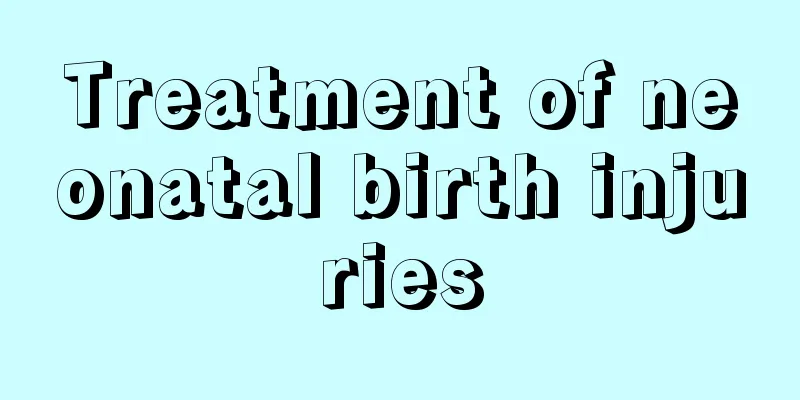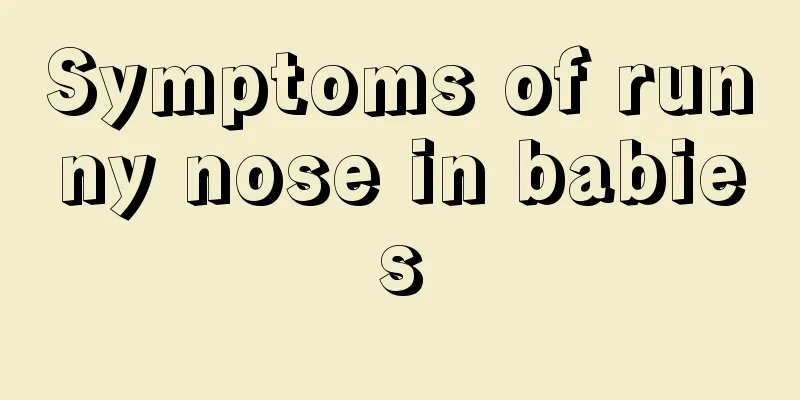Treatment of neonatal birth injuries

|
We may have seen many children suffering from neonatal birth injuries. This situation is related to the genetic relationship with our parents. In fact, neonatal birth injuries are not a serious disease, but a normal phenomenon. However, many parents hope that their children will grow up healthy and happy. Whenever our children have this situation, our mothers will be particularly anxious and angry. So is there any good way to treat neonatal birth injuries? Let us now learn about the treatment of neonatal birth injuries. Treatment: 1. Placement Inspect the device before insertion. Put the left leaf of the pliers first, then the right leaf, to close them. Hold the right leaf with your left hand, apply lubricant, use your right hand to guide it, and slowly insert it into the vagina. If the baby's head is in a low position, you can use the index and middle fingers to guide it; if the baby's head is in a higher position, you need to insert most of your hand into the vagina to guide it. When starting to insert, the forceps should be perpendicular to the ground, with the concave side of the forceps facing the perineum. Gently insert the forceps through the posterior wall of the vagina. Under the guidance of the right hand, slowly move forward along the curvature of the pelvis, moving toward the left side of the pelvis, and place it on the left side of the fetal head. After placing it properly, take out your right hand. At this time, the petiole is parallel to the ground. You can hold it with the ring finger and little finger of your left hand or have an assistant hold it. Then, using the same method, hold the right leaf of the forceps with your right hand, and under the guidance of your left hand, slowly insert it into the vagina and place it on the right side of the baby's head. (ii) Closing If the two leaves are placed properly, they can close smoothly. Otherwise, they can be moved slightly forward and backward and up and down to make them close, and the distance between the two handles should always be kept about the width of a fingertip. Do not put them too close to avoid excessive pressure on the fetal head. If it is difficult to close, it means it is not placed properly and should be taken out and put again. After closing, listen carefully to the fetal heart rate. If there is a sudden change, it may be caused by being too tight or clamped on the umbilical cord. It should be loosened and checked in detail. (III) Traction and clamping After closure, if the fetal heart rate is normal, traction can be started. Traction should be performed during contractions, and the force should gradually increase and then gradually decrease with the contractions. During the interval between contractions, the forceps should be released to reduce pressure on the baby's head, and pay attention to the fetal heart sounds. The direction of traction will change as the baby's head descends. At the beginning, the pliers handle should be parallel to the ground (if the head is in a higher position, it should be pulled slightly downward), and both hands should apply force in the direction shown. When the occiput appears below the pubic arch and the perineum is obviously bulging, you can use one hand to slowly lift it upwards to help the baby's head tilt back for delivery. After the baby's head is "crowned", the forceps can be removed. The order of removing the forceps is the opposite of that of inserting them. First remove the right lobe, then the left lobe, and then use your hands to help deliver the baby's head. Be careful to protect the perineum. (1) To prevent trauma caused by excessive force during traction, the operator should sit during traction, with arms slightly bent, elbows against chest, and apply force slowly. Do not stretch your arms or use your feet to push on the delivery bed to pull hard, so as to avoid losing control and causing serious harm to mother and baby. Those who lack arm strength can be pulled while standing, but they should have a good grasp of the force and direction of pulling. (2) In urgent cases, the fetus should be delivered as quickly as possible, but rough operation should never be performed. In general, traction should be performed as the contractions occur, and it usually takes 15 to 20 minutes. Exit forceps delivery can usually complete the delivery within minutes. (3) Do not hold the two handles of the forceps tightly during traction. You can put a small piece of gauze between the two handles to reduce the pressure on the fetal head. (iv) If difficulties arise, a detailed examination should be conducted and the method of delivery should be reconsidered as appropriate. Forced traction should be avoided. If necessary, cesarean section can be performed instead. (V) After the operation, pay attention to uterine contractions and bleeding, check the cervix and vagina, and if there is a tear, it should be sutured immediately. (6) For patients with a long labor process and hematuria during catheterization, a urinary catheter may be left in place and anti-infection drugs may be used as appropriate. (VII) Carefully examine the newborn, give hemostatic drugs and prevent infection. The above content introduces us to the situation of neonatal birth injuries. Through the above content, we must correctly guide children's habits in all aspects and never let children do whatever they want. This depends on the daily education of our parents. I hope the above content is helpful to everyone. |
<<: Is myocardial damage serious after a newborn cold?
>>: Treatment of thyroid deficiency in infants
Recommend
What to do if you have cough after having roseola in infantum?
The physical health of young children is easily a...
Why are my child's lips turning white?
The color of a child's lips can reflect the h...
What to do if Kawasaki disease recurs for the second time
Kawasaki disease is a common symptom among childr...
What to do if your baby has bloody stools
Many people have experienced red stools or stools...
Treatment of hip synovitis in children
Every child is the apple of the parents' eyes...
How to deal with a baby's first fever
When a baby has a fever for the first time, many ...
What medicine should be applied to children's scrotal itching
Many mothers know that little boys sometimes expe...
How to cultivate children’s patience?
Children generally lack patience, but they must d...
What are the methods for treating cerebral palsy in children?
The occurrence of cerebral palsy in children brin...
Moxibustion for children with cold
Moxibustion is a treasure of traditional Chinese ...
What medicine should I use for my child's allergy?
Children's skin is fragile, so when a child h...
Standard height and weight indicators for four and a half year old babies
I don’t know if you are aware of the age and heig...
What is the reason for the two-year-old baby's yellow hair?
The physical health of the baby is the most impor...
What to do if your child has itchy lips
Children are not able to take good care of their ...
Reasons for decreased appetite in two-month-old babies
In daily life, many mothers have found that many ...









